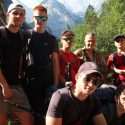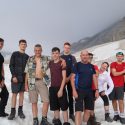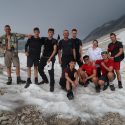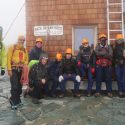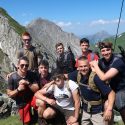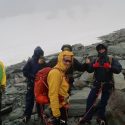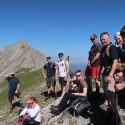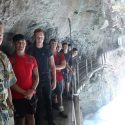After setting off from UK in the very small hours of 21st July, our team of 8 Cadets and 4 Adults finally reached our campsite in Garmisch in Southern Germany at around 7pm. To our South, towering above, stood Zugspitze, Germany’s highest mountain at almost 3000m high and as we gazed up, a debate then started between the Cadets as to how we would possibly get to its top.
The expedition’s aims were to introduce novices to Alpine trekking and basic mountaineering by attempting to climb Zugspitze and Grossglockner.
The following day was an admin and rest day and after getting out and stocking up on food supplies we concentrated primarily on getting ourselves sorted out, trying on kit and equipment and essentially, keeping ourselves hydrated. During the afternoon we ventured in to the Bavarian town of Garmisch and enjoyed walking through the busy streets of this typically Bavarian mountain resort.
At the time, Germany was having a heat-wave with daily temperatures peaking at around 34c by late afternoon. This clearly was going to pose a problem with training due to the very high temperatures; however we discovered the next day on our first excursion in to the mountains that the temperature was around 10c lower than at ground level; nonetheless, hydration was the key to staying mountain fit. Our first acclimatisation trek was along the Gartnerwand Ridge just across the border in Lermoos Austria; a 4km long limestone ridge rising to 2280m with great exposure on each side offering incredible views.
The following day, we started our long approach trek to Zugspitze through the Reintal Valley, an incredible 12km long deep valley with cliffs to each side rising over 800m. The valley trek starts in the amazing kilometre long Partnacklamm Gorge before opening out in to the valley and trekking initially through forest before opening out in to mountain moorland and eventually rising well above the tree-line. After 7 hours trekking we reached our overnight stop, the remote but very comfortable and busy Knorr hut at 2052m we settled in to a good evening meal.
This proved a very interesting experience for our cadets, sleeping on very long wooden bunk beds.
After an early breakfast we set off up a steep mountain path heading for the summit. Old winter snow lay patchy and deep in places as we navigated our way along a high plateau, then up a large scree slope and along a series of ledges and ridges, finally making the summit around 5 hours after leaving the hut. The summit is like no other, with a whole host of eateries and souvenir stalls. The team had worked hard to reach this point and after some well-earned lunch it was a simple pleasure to make the long descent via cable-car back to the heat of ground level, in surprisingly very little time.
Meanwhile back in the valley, after evening meal we packed what we could in anticipation of moving to Austria the following morning. The sun was still shining the next day as we struck camp and ate breakfast in the open, before setting off for our subsidiary activity which was white-water rafting along the River Inn. This was hosted by Outdoor Planet and proved to be one of the highlights of the trip with most Cadets giving an ‘awesome’ verdict to the activity. The starter package allows you 2.5 hours of level 3 rafting in a large dingy on very choppy and frigid glacier melt water; initially, the water temperature is a shock to the system but after you’ve been in a few times you become accustomed to it, but it’s also a pretty hard work out for the duration, trying to keep the raft going where the raft guide wants it to be.
From Haiming, we drove 3 hours to our next campsite in Kals Am Grossglockner, a lovely small and quiet mountain resort where we pitched camp got settled in for the evening. After taking a call from our mountain guides we learned that the following day’s weather was not looking good and instead of meeting at midday at Studle hut, we were to meet at 6pm when the weather should be improving.
However, come 2.30 pm the next day when we set off from the campsite, it was still raining and overcast and not looking at all good.
On arriving at the hut that evening, we met up and were briefed by our guides before settling in after a good hearty evening meal. Our early breakfast call at 3.30am arrived seemingly very quickly and after a good breakfast we kitted up for the start of the long climb to the summit of Grossglockner, Austria’s highest mountain at 3798m. However, the guides stood us down for 2 hours owing to the very poor conditions on the mountain. The upside was an extra hour’s kip, the downside was lost time. We finally set off in not so favourable conditions, though slightly improved. After an hour we reached the edge of the Kodnitzkees Glacier were we fitted crampons and roped to the guides for the traverse of the glacier. This proved a very adventurous experience for the Cadets and Cadet RSM Josh Culen-Forney said that he intended to be back to the Alps very soon for more of it.
From the glacier the climb of an exposed ridge begins where clipping in to a cable system is required and edging along ledge systems before finally reaching the remote and exposed Erzherog –Joann hut at 3454m, high on the mountain’s West flank and just 400m in height from the summit itself. Sadly the conditions remained poor and time was of the essence; we had reached a very respectable height and the guides had called time on our summit attempt, explaining that conditions on the summit were not good. After a brief stop in the hut for a big mug of hot chocolate we started our long descent back to Studle hut down the precarious ridge, across the glacier and finally arriving at the hut to depart from our guides. We then made the final 2 hours descent to our pick up point at the road head in much more favourable conditions.
Grossglockner hadn’t been so kind to us on this occasion, though our experiences in trying to gain her summit were memorable and life lasting. Cadet Cpl Corbyn Walsh said it had been an opportunity of a life time and when you hear comments like that then everything is put in to perspective.
From Kals we travelled a further 2 hours to Fieberbrunn and stayed in an Austrian Pension for a good rest and freshen up before starting the long journey back to Cheltenham, arriving 22 hours later at 0500 hours on the 31st July. It had been an incredible yet challenging experience for all with the usual highs and lows of being on an Alpine mountain expedition.
The expedition had been a challenging and rewarding experience to all involved. New skills were learnt and each Cadet had to on occasions dig deep to overcome personal physical and mental encounters which they adapted to and overcame through perseverance and team work. The impact on our unit should have a positive bearing on younger Cadets who can also look forward to similar expeditions in the future.
All the team members have expressed their gratitude to the Ulysses Trust for providing a significant proportion of funding to enable the expedition to happen and for them to subsequently gain their new and rewarding experiences.
The Ulysses Trust also wish to thank the generosity of the Army Sport Control Board for supporting this expedition britisharmysport.com

